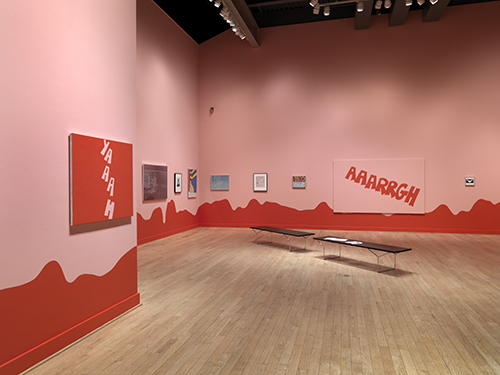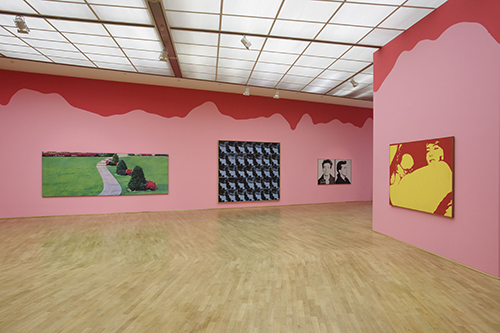
Carl Ostendarp, "Pulled Up," 2009. Installation view at the RISD Museum of Art, including "Aaarrgh," 2009.
Carl Ostendarp is an artist and teacher based in Ithaca, New York. A survey of his work was shown at Elizabeth Dee Gallery in New York City in 2007. He has also created mural installations at the RISD Museum of Art in Providence in 2009 and the Museum für Moderne Kunst in Frankfurt, Germany in 2007. After admiring his work for some time, I was recently able to ask Carl some questions about his curatorial projects and his interests in music.
Nathan Townes-Anderson: What’s the last rock show you went to?
Carl Ostendarp: I saw Black Dice play not too terribly long ago. It was at an opening party for a friend’s show, crowded and LOUD. The music was great, very physical and thought-killing, but actually the best part was watching people attempting to carry on their conversations, everyone yelling “WHAT!” over and over.
NTA: Rumor is that you don’t listen to CDs too much, but prefer vinyl and tapes…any particular reasons for this?
CO: The tapes and whatever CDs I have were brought in to play during studio classes [at Cornell University]. It makes an atmosphere for the work to go on in and I try to play a fairly wide range of kinds of things and invite the students to contribute as well. It structures the time and precipitates conversations.
At home, I mostly play vinyl. When I lived in New York, I used to carry a High School/College collection around in milk crates from apartment to apartment, never having space to unload and play them. When my son was about to be born, I realized that I had to pass them on, so I gave them to a friend who had the room and the interest. Then, after moving to Ithaca and renting a small house, I bought a turntable and a few used discs, at first replacing old favorites. Naturally, it’s become a problem which I justify to myself by thinking of medieval Irish monks preserving civilization during the dark ages.
I like the fact that the album (the whole package) is the experience – visual and aural.
NTA: I heard you brought in some LP covers to show some students last year. Which LPs did you end up bringing?
CO: Graham McDougal, a friend and colleague, was teaching a graphic arts course and asked me to bring some records in to show his students as examples of a kind of lost visual language. I remember choosing pretty obvious things: Pedro Bells’ Funkadelic covers, Blue Cheer’s Vincebus Eruptum, Sex Pistols’ Never Mind the Bollocks, Kyuss’ Welcome to Sun Valley—about 25 things in all, pretty much what you’d expect.

Installing "All Tomorrow's Parties" at MMK Frankfurt, 2007.
NTA: Switching gears…how do you approach your curatorial projects?
CO: First of all, I should tell you that I don’t curate often, at all. Usually there is first an opportunity and there are a couple of ways that things proceed. One way is very slow and involves thinking about work from a range of time periods or cultural categories, which I find myself responding to in a similar sort of way. Often this process lends itself to smaller, works on paper sorts of shows.
The other mode first came about more abruptly. A few years ago I was invited to produce a wall painting as part of an exhibition of the dealer Rolf Ricke’s collection at the MMK in Frankfurt. In the process of making proposals/studies I decided to collage xeroxed images of works from the museum’s Pop art collection as though they were hung on top of the mural. To my surprise, the museums’ director, Udo Kittelman, took me up on my fantasy and gave me a room to work with and access to the collection. Subsequently I was invited to work with the RISD Museum of Art Collection as part of a series of shows related to Warhol’s 1970 Raid the Icebox show.
NTA: For me, your work makes unexpected connections between artistic moments/movements understood as discreet. Would this be a fair way to characterize your curatorial practice as well?
CO: That’s fair, however I’m more concerned that the exhibited works are managed in such a way as to become available to direct and present experience. I had the sense, in Frankfurt, especially given that this Pop collection was the treasure of the museum and, in fact, the reason for the museums’ construction, that these works held such iconic and nostalgic affect that they were seen as some combination of artifact/visual text. That they were too easily seen as examples of themselves. I had the fairly obvious idea that they were concerned to some degree with a deadpan picturing of sex and violence, and that this fact might be made available in its’ varied expression from piece to piece.
NTA: Post-RISD, any insights on Warhol’s Raid The Icebox exhibition?
CO: I ended up thinking that Warhol’s show was an uninflected exposure of the particular bent of the RISD Collection, in that this place was the first U.S. museum to present clothing, ceramics, furniture, shoes, umbrellas, etc as assiduously as visual art. The other aspect of his show, which I also couldn’t attempt to be responsive toward (despite the generosity with which the curators opened their storage areas to me), was his sense of having turned the place inside out, both in the profusion of kinds of things and in the pragmatics of their display. His show, from the images of it, appears terrifically generous, mine less so.

Carl Ostendarp, "All Tomorrow's Parties," 2007. MMK Frankfurt. Latex on wall, soundtrack, dimensions variable.
NTA: I read Talking Heads 77 and Lighting Bolt were played at RISD, anyone else? The soundtrack at Frankfurt was only The Velvet Underground & Nico, right?
CO: At RISD we used “Pulled Up”, a song title from the Talking Heads 77 album for the show title. I wanted to make it clear that the show was, at least in part, directed to the attention of the art students. The Heads, being from RISD and their song which speaks to setting about leading a creative life seemed appropriate.
I also produced a soundtrack of songs from 30 different groups to be played in the space, the conceit of their grouping was that this was all “art school” music. And to that end, I interviewed students and guards, many of whom were former students, as well as friends. The list was by no means comprehensive, but included songs by The Stooges, The Replacements, Sonic Youth, Pixies, Pavement, P. J. Harvey, Super Furry Animals, Morphine, Flamin’ Groovies, etc.
At the MMK, playing the Velvet Underground and Nico album came about mid-stream. Somewhere in the middle of a fairly long installation we started to think about the show as a discrete piece, an Installation, as opposed to a room, and Udo asked me for a title. I had been reading a book about the history of the Velvets and the making of the album, and suggested we call the thing All Tomorrow’s Parties. I thought this pointed to what was still to be gotten from all these works.
I liked the fact that Warhol had produced the record, especially as we had so many Warhol paintings in the show; Soup Cans, Most Wanted Men, Jackies, Disasters, as well as this fantastic Elaine Sturtevant painting of one of Warhol’s Large Flowers. Also, there was Sturtevant’s version of Felix Gonzales Torres’ Go-Go Dancer piece, which had the dancer moving to the sounds of an iPod which are unavailable to us. Having the Velvets playing to the crowd who are themselves aware of the dancer listening to an unknown was great.
NTA: I understand your choice of music in these installations as site specific, historical, and also, poetic. Are there other examples of specific musical references appearing in your work?
CO: Yes, there are, but it’s worth adding that music can also turn the neat trick of orienting the viewer/visitor into the present tense – that’s important. In my other work, music and sound have come up in different ways pretty much as long as I’ve been making work. Early on painting titles often came from songs; Black Sabbath and “Quiet storm” type R&B titles (those were in the unreliable narrator category). There was a show of works; biomorphic abstractions made while my wife was pregnant with our first child which all used James Brown song titles. There were paintings of onomatopoeia words and more recently, I’ve been painting images of grotesque comic language, usually of bodily utterance, i.e. “AHHHHH,” or “ARGGHH.” I think that it’s somehow odd that paintings are silent or that the experience of them is, and so I think that I should be doing something about that.




Pingback: What’s Cookin at the Art21 Blog: A Weekly Index | Art21 Blog